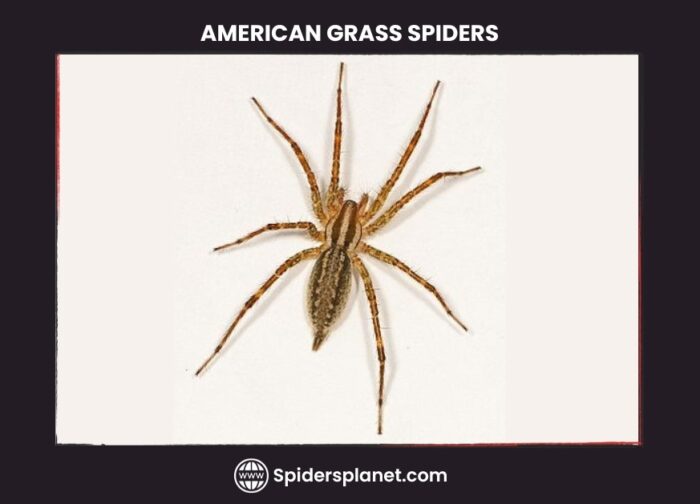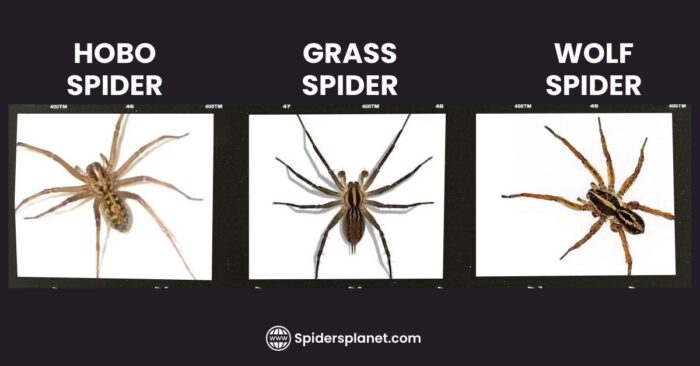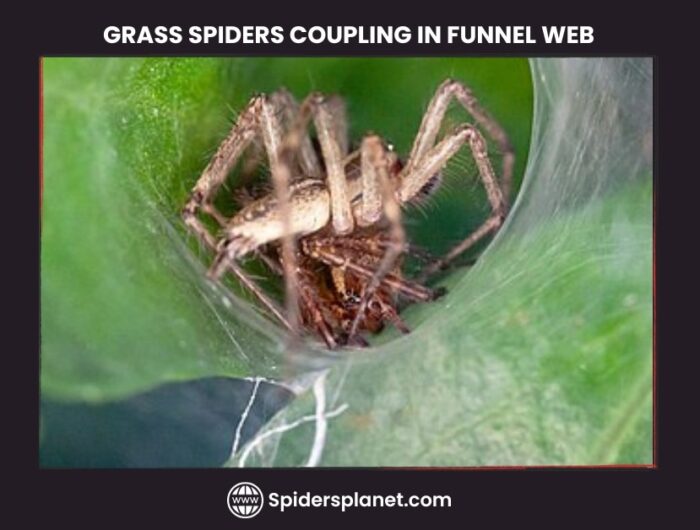The Grass spider is a tiny architect quietly crafting its marvels in our gardens and meadows. With a subtle appearance and amazing web-building techniques, they adapt masterfully, revealing nature’s brilliance in unexpected places.
These spiders typically inhabit grassy areas, in line with their name. Belonging to the category of funnel-web spiders, there are approximately 1,200 species similar to them. So, even though they love the grass, they leave their artistic mark in many other spots with their unique webs.
Let’s explore this eight-legged wonder to discover its home, what it eats, how it lives, and its lifespan. This web-weaving creature is like a silent artist in nature’s big show, taking the spotlight and weaving its story in the grand symphony of life.
Grass Spider Description:
Scientific Name and Family:
The Grass spider, scientifically known as Agelenopsis, is a type of funnel weaver described by C.G. Giebel in 1869. it belongs to the Animalia kingdom, Arthropoda phylum, Arachnida class, Araneae order, and Agelenidae family.
The term “Agelenopsis” breaks down into two parts: “Agelena,” referring to a genus known as Eurasian Grass spiders, and “opsis,” which means “to look like.” This combination essentially suggests that creatures falling under the name Agelenopsis share characteristics or appearances similar to those within the Agelena genus, particularly the Eurasian Grass spiders.

Species:
This versatile spider goes by various names worldwide, such as funnel web spiders, ground spiders, sheet web spiders, and funnel weavers. It is also important to mention here that grass spiders and grasshopper spiders despite having some similarities, the two belong to different orders within the class Arachnida (spiders) and Insecta (grasshoppers), and they have distinct adaptations and behaviors. In total, there are 14 known species, each contributing to the rich diversity of arachnids in the natural world.
- Agelenopsis actuosa
- Agelenopsis aleenae
- Agelenopsis aperta
- Agelenopsis emertoni
- Agelenopsis kastoni
- Agelenopsis longistyla
- Agelenopsis naevia
- Agelenopsis oklahoma
- Agelenopsis oregonensis
- Agelenopsis pennsylvanica
- Agelenopsis potteri
- Agelenopsis riechertae
- Agelenopsis spatula
- Agelenopsis utahana
Grass Spider Appearance and Identification:
Size:
Agelenopsis are around half to three-quarters of an inch long, and the females are bigger than the males. Females measure 0.39 to 0.78 inches, while males are about 0.31 to 0.70 inches long. They are lightweight, roughly 3 ounces, similar to jumping spiders.
Color:
They are often yellow-brown or brown also known as brown Grass spiders, sporting two dark stripes from their side eyes and thin lines on their carapace. The abdomen is darker with a lighter middle band, sometimes a bit wavy. They have long spinnerets on their abdomen, looking like short tails. It often gets mixed up with its arachnid kins, the wolf, and hobo spiders, primarily due to similar patterns on their head region.
Difference between Grass, Wolf, and Hobo Spiders:
If you take a close look, you will notice two black lines on either side of the midline, which are slightly lighter and thinner than those found on a wolf spider.
Another distinguishing feature is the abdomen, adorned with a series of dark chevrons that are lighter than those on wolf spiders. While the Agelenopsis does carry venom, its small fangs make it non-threatening to humans.

Below is a table summarizing the key differences between Grass spiders, hobo spiders, and wolf spiders
| Feature | Grass Spider | Hobo Spider | Wolf Spider |
|---|---|---|---|
| Family | Agelenidae | Agelenidae | Lycosidae |
| Size | Females: 10-20 mm; Males: 9-18 mm | Females: 11-18 mm; Males: 8-12 mm | Females: 13-37 mm; Males: 8-15 mm |
| Coloration | Yellow-brown or brown with darker longitudinal bands | Brown or tan with a darker brown pattern on the lower abdomen | Brown, gray, or black with a variety of markings |
| Eye arrangement | Two rows of eyes | Two rows of eyes | Two rows of eyes |
| Web type | Funnel-shaped web | Funnel-shaped web | No web; active hunter |
| Habitat | Grasslands, meadows, fields | Near buildings, under logs, in rock crevices | Variety of habitats, including forests, grasslands, and urban areas |
| Venom | Not considered dangerous | Not considered dangerous | Not considered dangerous |
Related Post: Knowing Your Jumping Spider Pet: A Comprehensive Guide
The Web:
This eight-legged spider is often recognized by its unique web rather than its appearance. Picture a horizontal sheet-like web with a funnel at the end, resembling a black hole. The sheet can stretch up to 3 feet, and the funnel may be a foot long.
The funnel part of the web leads to the spider’s safe spot, usually a rock or crevice. When prey touches the web, it signals the Agelenopsis, allowing it to swiftly attack.
Although the web is not super sticky, its shape helps trap prey, and the agile Grass spider pounces on them. You have likely come across the webs of grass spiders in your lawn.
Habitat:
These funnel web spiders mainly hang out and are quite common in North America, and they have made their way to some places in Central Asia, too.

If you want to find them, peek into not-so-clean spots in a house. They are not into the dirt, but that is where their dinner, small insects like ants, likes to chill. Areas with food scraps are like a buffet for Agelenopsis to build their webs.
Typically, you won’t find male Grass spiders indoors much. They prefer outdoor spots like lawns, gardens, plants, trees, foundations, log piles, under rocks, decorations in the yard, tubs, window wells, and sinks.
They hide in the funnel part of their webs and pop out when there is a tasty meal nearby.
What They Like to Eat?
Agelenopsis have a diverse menu, often munching on beetles, harvestmen, moths, and little butterflies. They zip out fast from their funnel-shaped hideout, needing to swiftly figure out if a vibration on the web is a tasty treat, a harmless fallen leaf, or something potentially dangerous to avoid. They have got to make split-second decisions!
Hunting:
Agelenopsis are proactive hunters and do not count on sticky webs to catch their food. Instead, they create funnel-shaped webs connected to plants or structures. While these webs are not sticky, they have tripwires that signal the spider when prey is around.
Once a bug sets off a tripwire, the spider dashes out from its funnel and hunts down the prey. These spiders are speedy runners, covering a surprising amount of ground in a short burst.
Lifecycle:
The life cycle of a Agelenopsis lasts only about a year and involves mating rituals that lead to the end for both partners. The male dies soon after mating. In late summer or fall, female Agelenopsis lay a white sac that lasts through winter. The female dies shortly after laying the sac. When the eggs hatch in spring, the spiders molt several times, becoming adults by late summer.
Like adult grass spiders, Grass spider babies (spiderlings) are skilled hunters. While they may not build the intricate funnel-shaped webs seen in adults right away, they exhibit predatory behavior, actively seeking and capturing small insects.
Facts:
The following additional facts further emphasize the unique characteristics and ecological significance of Agelenopsis in the natural world.
Nocturnal Behavior:
If you observe spiders in the grass at night, you may notice their reflective eyes shining when exposed to light. Agelenopsis are predominantly active at night, classifying them as nocturnal creatures. This behavior corresponds with their hunting patterns, as they emerge under the cover of darkness to search for prey.
Cannibalistic Tendencies:
Grass spiders exhibit cannibalistic behavior, occasionally preying on their own kind. This behavior may be influenced by factors such as competition for resources or territory, reflecting the complex dynamics within their population.
Ecological Importance:
Agelenopsis play a crucial role in the ecosystem by contributing to insect population control. Being active hunters, they play a crucial role in regulating the populations of various insects, contributing to the balance of local ecosystems.
Preventive Measures
American grass spiders are much of a threat to people. They are shy and not aggressive, and their bites, while causing pain and discomfort, are not known to be fatal. If you find them in your home due to their webs, they are likely just hiding and not causing trouble.
However, if you have a lot of small insects, you should address that to avoid a Agelenopsis issue. Their webs can make your yard look messy and neglected. To discourage these eight-legged pests, consider the following landscaping and sanitation tips:
- Regular lawn maintenance reduces tall grass and weeds, minimizing hiding spots for spiders.
- Keeping plants and bushes trimmed reduces potential hiding places for Agelenopsis pennsylvanica and their prey, making your property less appealing to them.
- Piles of debris provide hiding spots for spiders and their prey. Removing these will discourage them from establishing a habitat.
- Regularly removing spider webs helps discourage spiders from establishing a presence in your place.
- Try natural methods like diatomaceous earth or essential oil sprays to control Grass spiders without harmful chemicals.
By following these tips, you can create an environment less conducive to the growth of Agelenopsis pennsylvanica populations around your home or business.
Related Post: Zebra Spider: Habitat, Diet, Reproduction & Facts
FAQs:
What are the predators of Grass spiders?
Grass spiders have some predators, like lizards, birds, and centipedes, that like to snack on them.
How long do they live?
Agelenopsis pennsylvanica, like many other spider species, generally have a lifespan that spans one year or even less. The lifespan of individual spiders within a species can vary, and some may not survive to reach adulthood due to predation, environmental factors, or other risks.
Are grass spider poisonous?
Although Grass spiders are venomous, their venom is generally non-dangerous, and their bites are typically not of serious concern. The symptoms of a Grass spider bite are typically mild and include pain, swelling, redness, and itching. Typically, these symptoms tend to disappear in a matter of days.
Final Thoughts:
In summary, the Agelenopsis is a subtle architect in gardens and meadows, adding to nature’s diversity with its unique webs and versatile skills. With 14 species in the Agelenopsis genus, it stands out with its horizontal sheet-like web and agile hunting style.
While mainly found in North America, these spiders have also reached parts of Central Asia. Feeding on beetles, harvestmen, moths, and butterflies helps control insect populations. Despite being nocturnal and sometimes cannibalistic, Grass spiders rarely pose threats to humans and have a short one-year lifespan. Simple landscaping can peacefully deter them, letting us value their ecological role in nature’s intricate dance.




Leave a Reply